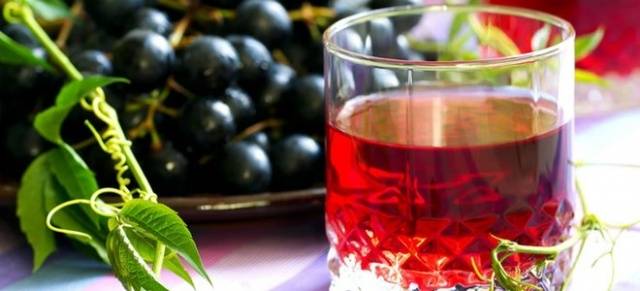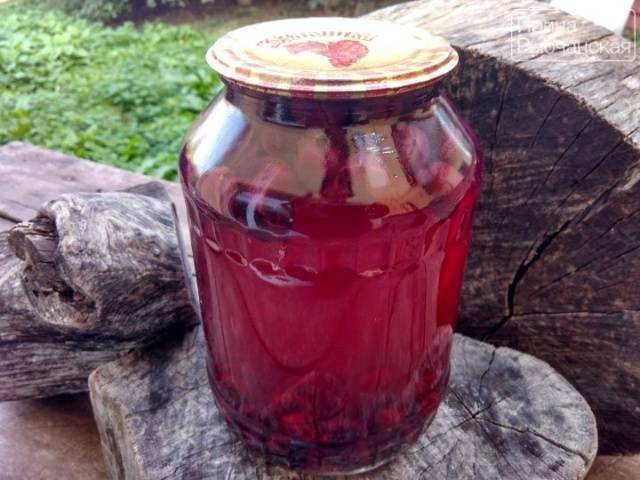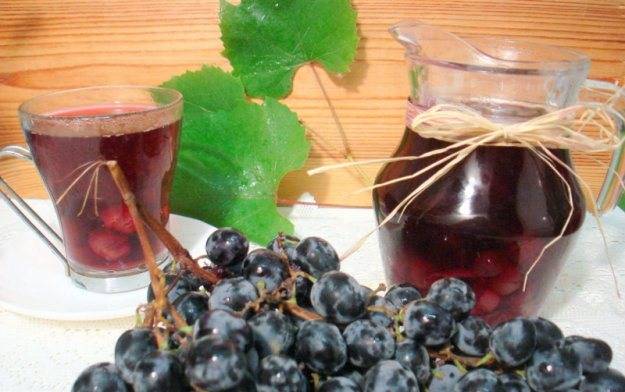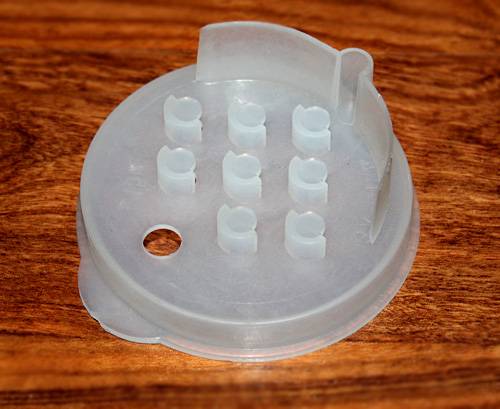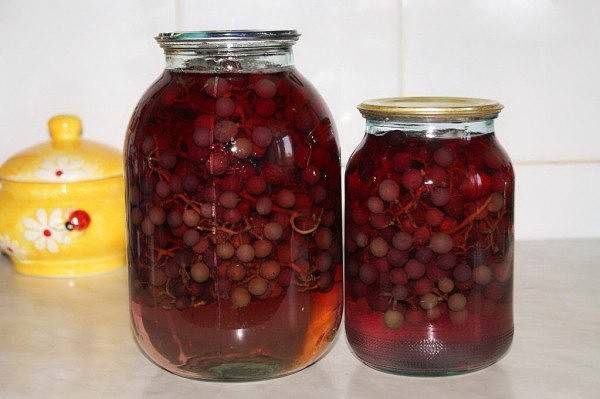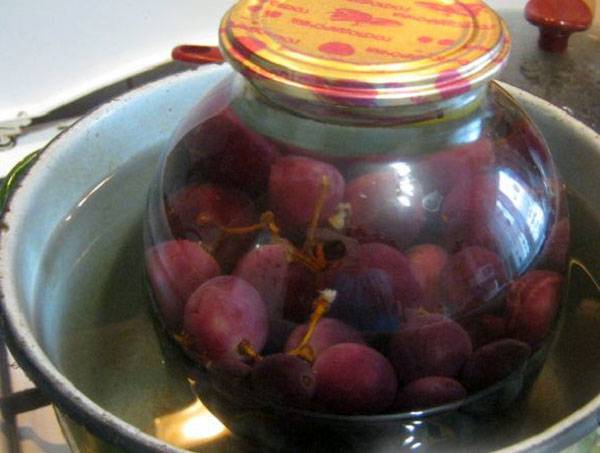Content
Isabella grape traditionally considered a typical wine variety and indeed, homemade wine from it is of excellent quality with an aroma that cannot be confused with any other grape variety. But for some people, wine is contraindicated for health reasons, others do not drink it for fundamental reasons, and they want to prepare grapes of this variety for the winter, since its yield is quite high. And in the fall, Isabella grapes are offered everywhere on the market, often for a symbolic price. But this grape variety is very valuable, because it has amazing healing properties: it relieves fever and the condition of patients with colds and viral diseases, improves metabolism, helps with anemia, liver and pancreas diseases, and is also used as a diuretic and cleansing agent.
Isabella grape compote for the winter will be the best way out, since the berries are stored in it quite well, it is prepared simply and quickly, and the taste of the drink itself can be further diversified with spices, as well as other berries and fruits.
Homemade compote from Isabella
As mentioned above, Isabella grapes at the time of their ripening can be offered on every corner, and in more southern regions it grows in almost every yard. Therefore, many caring mothers and grandmothers try to please their family by making all kinds of desserts from it. If you are thinking about how to cook Isabella grape compote so as to diversify its taste, then below are some useful tips:
- Try adding a few slices of lemon or orange to the compote while making it, right along with the peel, which contains the main citrus aroma. Just do not forget to remove all the seeds from citrus fruits before that - they can give bitter notes to the finished drink.
- To add spice to the grape compote, add a few grains of cardamom, cloves or star anise, a pinch of cinnamon or vanilla, or a handful of mint or lemon balm.
- The grapes go well with other fruits and berries. It is very good to add thinly sliced pieces of apples, plums, nectarine, pears or quince to the compote. Of the berries ripening at this time, dogwood, mountain ash, viburnum, blueberries, lingonberries and remontant raspberries are appropriate.
The most delicious recipe
According to this recipe, compote from Isabella grapes was prepared for the winter by your grandmothers and, perhaps, great-grandmothers. Nowadays, only some devices have been invented that greatly facilitate the work of the hostess, which will be discussed below.
Preparation of grapes consists in the fact that first the bunches are thoroughly washed in running cold water. Then strong, whole, intact and dense berries are selected from the brushes into a separate vessel, everything else can theoretically be used for wine or grape jam, but set aside for a while. Selected berries are best dried in a colander or on a towel.
According to the recipe, 1 kg of washed and peeled grapes is used for two two-liter jars. Sugar should be taken, depending on your taste, from one to two glasses. But it should be remembered that if there is too little sugar, then the compote runs the risk of souring already in the first months of storage. Conversely, too much sugar can cause an inadequate fermentation reaction. The best option for making syrup is to use 150-200 grams of sugar in 2 liters of water.
Fill sterilized jars with prepared grapes. If you need the compote to be intended only to quench your thirst and have only a grape aroma, then cover the bottom with grapes and this will be enough. But in order for the grape compote to resemble real juice, one two-liter jar will need at least 500 grams of grape berries.
If you have a shortage of glass jars, and you urgently need to close the grape compote, you can even fill the jars with grapes almost entirely, up to the shoulders. In the future, the compote will turn out to be just very concentrated, and when you open the can, it will need to be diluted with boiled water.
Boil the sugar syrup by boiling it for 5-6 minutes. After preparing the syrup, while hot, gently pour it into the jars of grapes. After that, leave them for 15-20 minutes.
This is where the fun begins.
In ancient times, when the recipe for multiple pouring was just being invented, this process was rather complicated and laborious. Witty housewives did not invent anything to make their life easier - they used a colander and made holes with a nail in the lids.
Nowadays, any interesting idea is picked up very quickly, and already some time ago amazing devices have appeared - plastic lids for glass jars of a traditional size with many holes and with a special drain. They became known as drain caps.
Now you just need to take such a lid, put it on top of the jar and pour all the liquid contents of the jar into a separate pan without any problems. Then take it off, put it on the next can and repeat the process in the same sequence. Thus, one lid can be used on an unlimited number of cans as many times as you want.
After you've drained all the syrup back into the pot, bring it back to the boil and simmer for 5 minutes. Pour the syrup in the grapes in the jars again, keep the allotted time and again pour the syrup through the lid back into the pan. The third time, after pouring the syrup into the grapes, the jars can be rolled up and, having tipped them upside down, wrapped in warm blankets until they cool completely.
Grapes with scallops
Many novice housewives may have a question: "How to close Isabella grape compote with twigs for the winter and is it possible to do this?" Of course you can - such a blank will not only look very elegant and original, but after opening the can you can surprise your guests and family by gradually pulling out a long bunch of grapes folded many times out of the can. If, of course, you can find one and put it neatly in the jar.
Cooking grape compote with twigs or scallops, as they are sometimes called, will take you even less time, since there is no need to inspect each berry and remove all twigs.
But nevertheless, the bunches of grapes must be very thoroughly washed, preferably under a running stream of water and examined for the removal of soft, overripe or rotten berries.
Twisting without sterilization
Arrange the washed and dried bunches in sterilized jars so that they occupy about half of the jar in volume.According to the recipe for 1 kg of prepared grapes, it is necessary to use 250-300 grams of granulated sugar. Pour the required amount of sugar into the jars, based on how many grapes you have used.
Boil the water separately and pour it carefully and gradually into the jars of grapes and sugar. Close the jars immediately after pouring boiling water using sterilized lids. Banks must be left wrapped before cooling, so that the process of additional self-sterilization occurs.
Preparation of compote with sterilization
Since the bunches of grapes according to this recipe will necessarily be sterilized, the jars should be thoroughly washed with soda and rinsed well with water. There is no need to pre-sterilize them. As in the first case, the grape twigs are neatly laid out in jars and filled with hot syrup. The syrup is prepared at the rate of 250 grams of sugar per 1 liter of water used.
Then the jars of grapes are covered with lids.
Then they are placed in a wide pot of water, which is put on the fire. After boiling water in a saucepan, liter cans are sterilized for 15 minutes, two-liter - 25 minutes, three-liter - 35 minutes. At the end of the sterilization process, the cans are carefully removed from the water and immediately closed with tin lids using a seaming machine.
Conclusion
Isabella grape compote is equally good in the ripening season, when it is able to perfectly quench thirst, and in the form of preparations for the winter. Moreover, in winter you can not only drink it, but also make a variety of fruit drinks, fruit drinks, sbitni and jelly out of it. Often, even a cream for cakes and fruit desserts is prepared on its basis.
